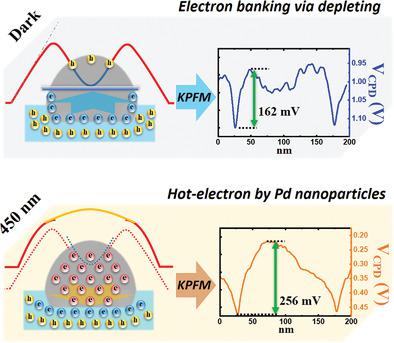当前位置:
X-MOL 学术
›
Adv. Opt. Mater.
›
论文详情
Our official English website, www.x-mol.net, welcomes your
feedback! (Note: you will need to create a separate account there.)
Visible Light Driven Hot‐Electron Injection by Pd Nanoparticles: Fast Response in Metal–Semiconductor Photodetection
Advanced Optical Materials ( IF 8.0 ) Pub Date : 2020-11-09 , DOI: 10.1002/adom.202001505 Liang Chen 1 , Sui Mao 1 , Pu Wang 2 , Zhao Yao 3 , Zhonglin Du 1 , Zhijun Zhu 1 , Laurence A. Belfiore 4 , Jianguo Tang 1
Advanced Optical Materials ( IF 8.0 ) Pub Date : 2020-11-09 , DOI: 10.1002/adom.202001505 Liang Chen 1 , Sui Mao 1 , Pu Wang 2 , Zhao Yao 3 , Zhonglin Du 1 , Zhijun Zhu 1 , Laurence A. Belfiore 4 , Jianguo Tang 1
Affiliation

|
Hot‐electron injection induced by plasmon decay enables ultrafast electron transfer in femtosecond scale and therefore endows metallic nanoparticles (MNPs) promising potentials in high‐speed optoelectronics. With much higher density of states next to its Fermi level, palladium (Pd) can more efficiently launch hot electrons according to the theoretical prediction, as compared to the conventional plasmonic NPs. In this work, the optical properties of Pd NPs as well as the plasmon induced hot‐electron injection are investigated through confocal Kelvin probe force microscopy. Analysis based on surface potential redistribution suggests Pd NPs can initiate dense hot‐electron transfer in visible range. According to the photocurrent characterization of photo field effect transistors, in cooperation with TiOx the Pd NPs launch a rapid photocurrent increase with the excitation of 450 nm light as the hot‐electron injection improves the electron depleting situation in TiOx thin film. The result confirms that Pd hot electrons can be energetic at visible range for photoelectric applications.
中文翻译:

钯纳米粒子的可见光驱动热电子注入:金属-半导体光电检测中的快速响应
由等离激元衰减引起的热电子注入可以实现飞秒级的超快电子转移,因此赋予了金属纳米颗粒(MNP)广阔的光电子前景。与传统的等离子体NP相比,根据理论预测,钯(Pd)具有接近其费米能级的高得多的状态密度,因此可以更有效地发射热电子。在这项工作中,通过共聚焦开尔文探针力显微镜研究了Pd NP的光学性质以及等离激元诱导的热电子注入。基于表面电势重新分布的分析表明,Pd NPs可以在可见光范围内引发致密的热电子转移。根据光场效应晶体管的光电流特性,与TiO x配合使用随着热电子注入改善了TiO x薄膜中的电子耗尽状况,Pd NPs随450 nm光的激发而迅速增加了光电流。结果证实,对于光电应用,Pd热电子可以在可见光范围内高能。
更新日期:2021-01-04
中文翻译:

钯纳米粒子的可见光驱动热电子注入:金属-半导体光电检测中的快速响应
由等离激元衰减引起的热电子注入可以实现飞秒级的超快电子转移,因此赋予了金属纳米颗粒(MNP)广阔的光电子前景。与传统的等离子体NP相比,根据理论预测,钯(Pd)具有接近其费米能级的高得多的状态密度,因此可以更有效地发射热电子。在这项工作中,通过共聚焦开尔文探针力显微镜研究了Pd NP的光学性质以及等离激元诱导的热电子注入。基于表面电势重新分布的分析表明,Pd NPs可以在可见光范围内引发致密的热电子转移。根据光场效应晶体管的光电流特性,与TiO x配合使用随着热电子注入改善了TiO x薄膜中的电子耗尽状况,Pd NPs随450 nm光的激发而迅速增加了光电流。结果证实,对于光电应用,Pd热电子可以在可见光范围内高能。











































 京公网安备 11010802027423号
京公网安备 11010802027423号